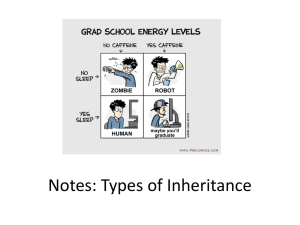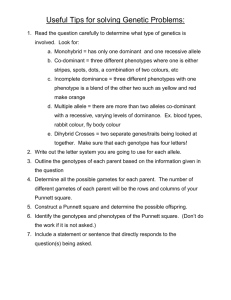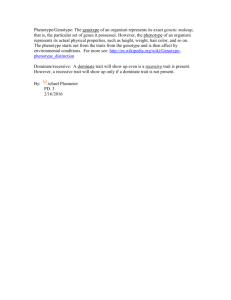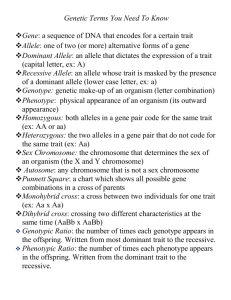Types of Dominance
advertisement
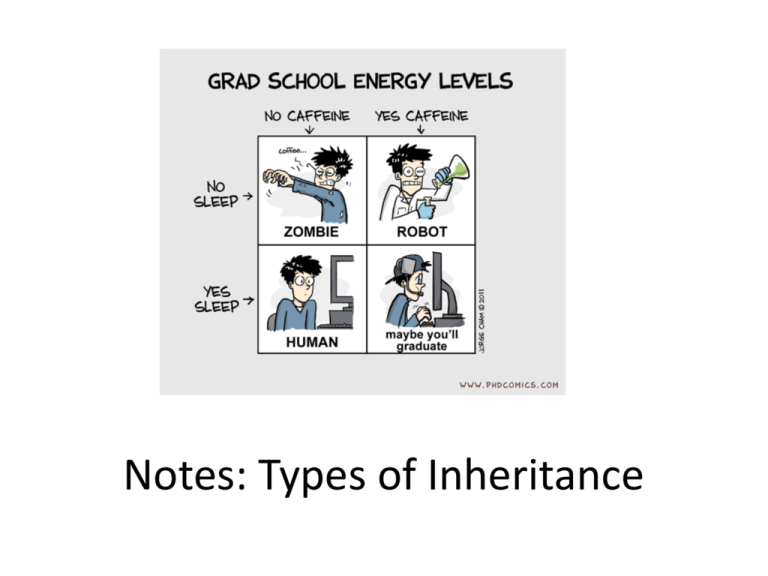
Notes: Types of Inheritance Think about it • You have a purple flower, you know purple is the dominate allele, but you do not know the genotype of the plant. • How could you figure out it’s genotype? – Assume that you do not have access to the technology to sequence the alleles Test Cross • Used to determine the genotype of an individual that displays a dominant trait. – Either PP or Pp • Cross with homozygous recessive (pp) • If in the offspring, there are pp individuals, then the parent had to be Pp Types of Inheritance • • • • • • Complete Dominance Incomplete Dominance Codominance Sex-linked Polygenic Epistasis Complete Dominance (What we have been looking at so far) • • • • One allele is completely dominant over the other Only two phenotypes exist One phenotype is masked The heterozygous phenotype shows dominant trait – – – – Ex: Purple flowers are dominant to white PP= purple Pp= purple pp= white Complete Dominance Autosomal Recessive Genetic Disorders *Carrier: A heterozygote for a recessive disorder/trait (ex. Cc). • Carrier does not show symptoms but can pass recessive allele to offspring • Affected person must inherit two recessive alleles • Example Cystic Fibrosis, Tay-sachs, sickle-cell anemia • CC & Cc = unaffected • cc = affected Practice Problem A male and female are both carriers for sickle-cell anemia. What percent chance do they have of having a child with sickle-cell anemia? Incomplete Dominance • Neither allele is completely dominant over the other • Three phenotypes exist • The heterozygous phenotype is in between the two homozygous parents (2 alleles are partially expressed) Incomplete Dominance • Neither allele is completely dominant over the other • Three phenotypes exist • The heterozygous phenotype shows a blended trait • Ex: Four o’clock Flowers can be red, pink, or white. – RR=red – Rr =pink – rr= white Incomplete Dominance • Example: Four o’clock flowers • Cross two pink flowers – What percent of their offspring will have white flowers? Incomplete Dominance • Fish can be green (GG), blue (BB), or teal (GB) a mix of blue and green Green (GG) Teal (GB) Blue (BB) Codominance • Both alleles are dominant and are fully expressed • Neither phenotype is masked • Three phenotypes exist • The heterozygous phenotype shows both traits at once Codominance EX: In Smileys, eye shape can be starred, circular, or a circle with a star. Write ALL the phenotypes and genotypes that exist. Codominance EX: In Smileys, eye shape can be starred, circular, or a circle with a star. Write ALL the phenotypes and genotypes that exist. • CC = circle SS = star SC = circle-star Codominance Ex. Cattle fur color – Red and white fur are codominant – When you cross a red and a white cow, a red and white spotted cow is produced (this color is known as roan) = X red (RR) white (WW) red & white(WR) (this color is called roan) Types of Inheritance • • • • • • Complete Dominance Incomplete Dominance Codominance Sex-linked Polygenic Epistasis Sex-linked • Disorder/trait found on the “X” chromosome Hint to remember which chromosomes (seXlinked) Sex-linked • Disorder/trait found on the “X” chromosome • Which gender has more instances of having an x-linked disorder? • Men: Males do not have second copies of the X chromosome (XY). Unless they have a genetic disorder. • Females have two X chromosomes (XX) so if one has a defect the normal chromosome masks the defect on the other Sex-linked • Making a sex-linked Punnett square – Punnett square determines sex and trait – First, use X and Y to show gender – Second, use a letter on the X chromosome to show which allele they have – DO NOT put a letter on the Y chromosome, the trait is not on that chromosome Sex-linked • EX: color blindness Possible genotypes and phenotypes: XR XR = Female, normal vision XR Xr = Female, normal vision Xr Xr = Female, color blind XR Y = Male, normal vision Xr Y = Male, color blind Sex-linked What is the probability of having color blind children if a female carrier and a male who has normal vision had children? Solve on notes Polygenic • Many genes may interact to produce one trait • Ex: Skin color is the result of three genes that interact to produce range of colors Epistasis • When other genes affect the phenotype of a specific gene • Ex. Coat color in Labs B= black, b=brown E is for epistatic gene, E=no change to coat color phenotype, e=change to coat color phenotype • B_E_ is a black Lab • bbE_ is a brown Lab • _ _ ee is a yellow Lab • The blank spaces represent either the dominant or recessive allele, it does not matter which is inherited, the coat will be that color no matter what! Pleiotrophy • One gene controls many traits • EX: Albinism • Albinos are unable to synthesize melanin, the pigment molecule responsible for eye, skin, and hair/fur coloring • It also results in poor vision and decreased immunity Environmental impact on phenotype • What about color-changing hydrangeas? • This is not due to genetics, but by the environment • When grown in acidic soil the flowers are blue, and in basic soil are pink

